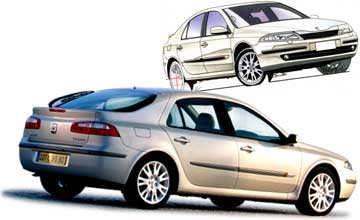BY TIM BRITTEN | 23rd Sep 2003

There is certainly more than a handful of car-makers with prestige aspirations who seem to believe this – or something like it - is the case, although some clearly have little chance of making it.
The problem, for most, is their traditional associations with the lower end of the market. It’s not easy to lift by the bootstraps a badge that has been associated with $13,999 driveaway deals.
Then there is another group that inspires nagging suspicions that their products might have what it takes.
Renault has never offered $13,999 driveaway deals in Australia and is one car-maker with what appears to be the right credentials. It’s European for one thing, which is always a good starting point when convincing would-be customers of your worth.
And, with its Laguna model, it has what appears to be the right product. Even though prices begin somewhat below the roughly determined $50,000 prestige entry point, the Laguna is a sleek, nicely balanced car with enough European character to appeal to buyers requiring a touch of individuality.
And, if they want, they can spend almost $60,000 to prove the point. Easily as much as a slightly above base level Mercedes C-class or BMW 3 Series. There is a small problem, though, in that a Laguna can also be bought for as little as $40,000, blurring the view of what the car actually represents.
If you were trying to balance somewhere between totally indulgent luxury (the $58,000 Privilege LX) and a more carefully considered approach, the less expensive – but still luxurious – Privilege model might sound like a better deal.
At not a lot more than $50,000 it comes with the same 3.0-litre, 152kW V6 engine as the LX, and includes things like alloy wheels, part-leather seats (with power adjustment for the driver), six-stack CD player, climate-control air-conditioning, Xenon headlights, six airbags and a host of electronic safety systems such as traction control, ABS brakes with brake assist and a stability control program.
On top of that it has a commodious hatchback body, complete with split-fold rear seats, that none of its German opposition offers, yet still has the air of a quiet luxury saloon.
In fact, the Laguna, compared with a C-class or 3 Series, is actually a slightly larger car, which means it offers excellent interior space as well as being undeniably handy as a luggage carrier.
The interior is obviously designed by the French, with plenty of swooping shapes and little of the finesse of the Germans, but it generally works well in terms of driver ergonomics, comfort and easy passenger access.
The seats prove to be generally quite cushy on the road, revealing a non-sporting nature through their lack of the lateral retention that keeps passengers firmly in place on corners.
But the back seat passengers are made to feel important in a wonderfully comfortable, spacious environment that is an object lesson to the Germans in how to look after all passengers - not just the two riding up front.
The ride quality, apart from a little low-speed abruptness, is very good, which means passengers feel great but the driver is left with the impression of being somewhat out of touch with what is actually going on dynamically.
Handling is best described as vague, while the steering does little to communicate the vagaries of the road surface.
The hatchback cabin also promotes a little resonant booming – something you don’t get in a sedan unless it’s particularly badly designed – and there’s also some wind noise to detract slightly from the overall experience.
But the V6 lifts the 1466kg Laguna along quite swiftly, denying the manufacturer’s claim of a tardy 12.3 seconds from zero to 100km/h.
In reality, the Laguna is able to keep easily in touch with any of its competitors and the multi-valve engine is smooth, quiet and generally unobtrusive. It is reasonably economical too, and will return better than 10 litres per 100 kilometres with sensible driving.
Unfortunately the five-speed automatic is too clever for its own good at times and becomes slightly indecisive, stumbling and fumbling at times as it tries to find the correct ratio for the job. It’s far from being an impressive automatic.
From a safety viewpoint the Laguna rates highly – its European NCAP five-star rating must have been embarrassing for some more prestigious car-makers – with dual front airbags, front side airbags and full-length curtain airbags all helping to minimise passenger injuries in a collision.
The Laguna is a good-looking car too, with a pleasant on-road presence and an overall stylistic balance that contrasts with the attempted quirkiness of its French competitor, the slightly slabby – but identically engined and generally surprisingly similar - Citroen C5.
If you think that only a spinning propeller or three-pointed star is able to convey true prestige, then the Renault might not do anything for you.
But if you are looking for style, practicality, true comfort and a decent turn of performance, the Laguna is an impressive contender in the lower reaches of the prestige car market.